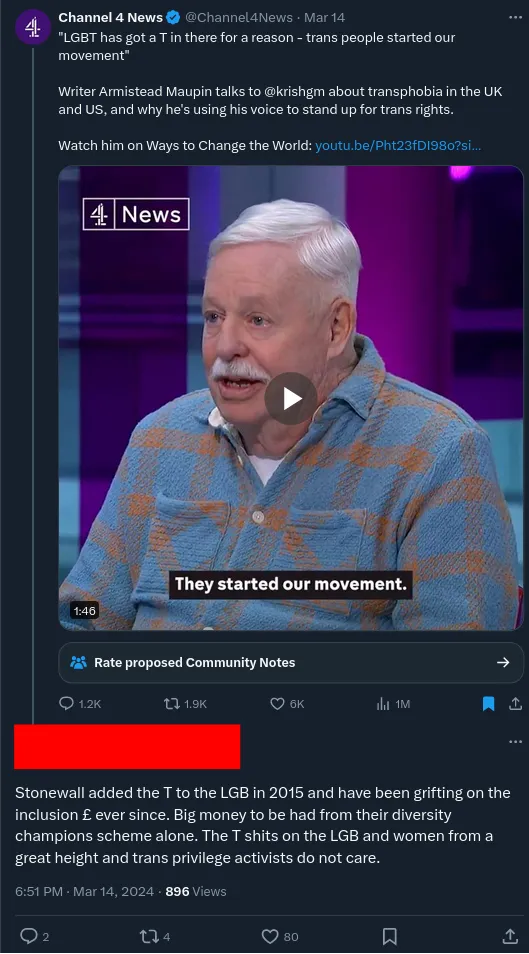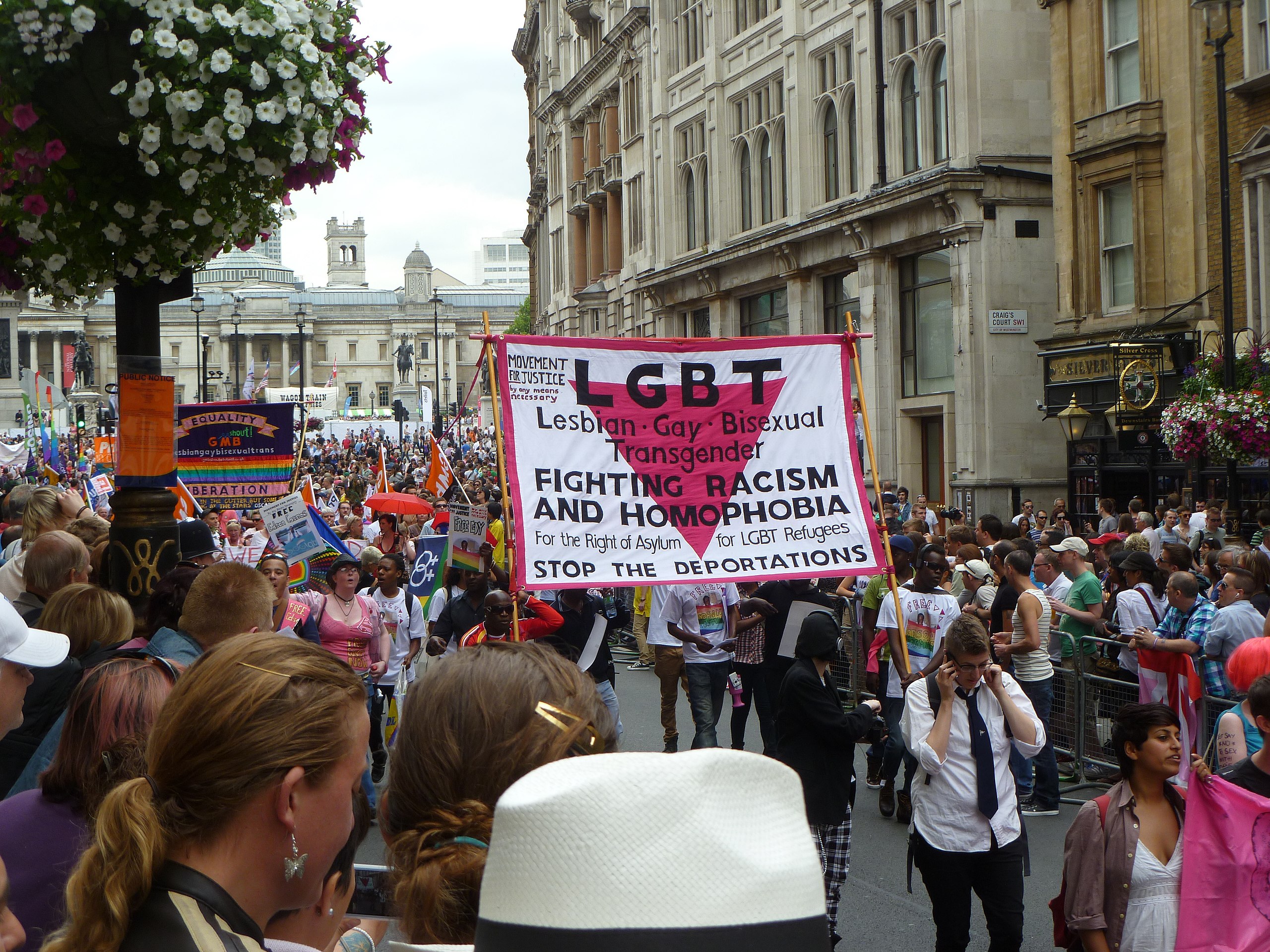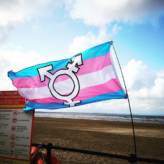Disinformation about queer rights history is rife and often spread by people pushing an anti-trans agenda by, somewhat successfully, arguing that T is new and dragging the rest of the acronym down. But is that true? Answering the question when was the T added to LGBT? Sarah Clarke writes;
How long has the acronym for various gender and sexual minorities been LGBT(Q+)? There’s a common and incorrect claim by anti-trans activists, such as painfully heterosexual conversion therapy enthusiast James Esses, that the T was added to LGBT around 2014/2015 by UK Charity Stonewall.
They claim this alone took transgender people from a place of being “all but alien to the UK” to “ubiquitous” in under a decade. You don’t have to look far find transphobic “gender critical posters” loudly telling LGBTQ+ community legends like author Armistead Maupin that they are wrong to support transgender liberation because of this.

There are some, albeit minor, truths to this. In 2014 Stonewall did in fact begin recognising trans struggles as relevant to their work. Another major UK based charity, then called The Lesbian and Gay Foundation also changed its name to the LGBT Foundation (skipping “LGB” altogether) in 2015. It’s from these facts that transphobes have derived their conspiracy theories that T has been “forced” on the queer communities by these charities.
It’s relatively trivial to show the presence of trans people in community and shared struggle with the LGB bit of the acronym throughout 20th century history, from Weimar Germany to the Gay Liberation Front and lesbian feminism. But that doesn’t tell us about the acronym itself – it doesn’t tell us when T was added to LGBT.
“In the GLF era, the word transgender, with its current meaning, barely existed. It was little known and rarely used. Back in those early days, gay was, for most of us, an umbrella word for all lesbian, gay, bisexual and trans people.” — Peter Tatchell, quoted by Emma Powys Maurice, The UK’s Gay Liberation Front had trans rights at its heart — despite what transphobes might try and tell you, Pink News, 2021
Let’s start with the uncontroversial parts. The modern LGBTQ+ movement has its roots in the gay liberation movement of the late 1960s and early 1970s. While organisations for “homosexual rights” such as the Mattachine society existed before this, their tactics, rhetoric and general aesthetic bore little resemblance to the raucous, radical queerness of gay lib.
In this time, the movement was known as either “gay” or “gay and lesbian”, despite the name, bisexual and trans people were very much present. During the 1980s, it became increasingly common to talk about the GLB (gay, lesbian and bisexual) and LGB (lesbian, gay and bisexual) movement in a move to recognise the longstanding involvement of bisexuals in the movement.
As with LGB/GLB before it, the T was added to LGBT in the 1990s as a recognition of a history that we already knew about. LGBT has been in common use since the early 90s, first overtaking “LGB” in frequency of usage in 1991 and “GLB” in 1996, according to Google Books’ database of English language texts.
Pride marchers protesting Section 28 in London in 1998 proudly carried a banner that spelled each letter of the acronym; “Lesbian Gay Bisexual Transgender” and US civil liberties NGO the ACLU has been using LGBT since at least 1999. The National Union of Students added the T to LGBT in November 2004, when the LGB Campaign first agreed to change it’s name to the LGBT Campaign, following suit from many University LGBT societies who had already made the change.
Far from LGBT being an imposition on the community by Stonewall in 2015, the reality is that organisations like Stonewall and the LGBT Foundation in 2015 were playing catch-up to the community, where T had been added to LGBT since the early 90s.
So what is at stake here? Why do we or cis het anti-trans activists like James Esses care exactly when LGBT became the most common way to describe the community of gender and sexual minorities? I’d argue that the myth that the T was “added by Stonewall” in the 2010s serves two different but related functions for two different subsets of the anti-trans movement.
Openly homophobic right wingers have made no secret of their desire to break up the “alphabet soup” of LGBTQ+ in order to have an easier fight against two smaller, divided groups instead of one unified movement. For groups like the Family Research Council, it serves their interests to portray trans liberation as something imposed on and unwanted by LGB people.
For liberal transphobes, including the small minority of anti-trans “LGB” activists, it’s perhaps a touch more complicated. They don’t want to be openly associated with homophobes like the FRC or their UK equivalents and they really, really, don’t want you to draw comparisons between their activism and anti-gay activism.
The fact of trans participation in the movement, from “gay liberation” to GLB to present, is a problem for these anti-trans actors. It is ideologically necessary for liberal transphobes to erase that history by pretending T was added to LGBT very recently. In order to pretend that their transphobia is meaningfully morally different to homophobia or biphobia they have to pretend that the LGBs want nothing to do with those dirty Ts and Qs.
So what does the community at large think? Today, the overwhelming majority of the community uses some variant on LGBT(QIA+), with a 2023 YouGov poll finding that 84% of LGBTQ+ people (more than 8 in 10) preferred an acronym with at least the first 4 letters, compared to a mere 3% (about 1 in 30) preferring the gender critical nom-de-gay LGB.
This is unsurprising, given the overwhelmingly positive view most cis LGB people have of trans people, with three quarters of cis LGB people viewing trans people favourably. When it comes to the claim that “the T” is alien and has been imposed form outside, it seems like LGB people just aren’t buying it.

